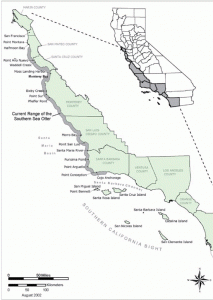Enhydra lutris nereis
- Threatened – Endangered Species Act (1977)
- Fully Protected – California Department of Fish and Wildlife
- Protected – Marine Mammal Protection Act
- Endangered – IUCN Red List (2015)
Out of all the animals found in national forests, the sea otter is not first to come to mind. Interestingly though, the Los Padres is the only national forest in the country that has southern sea otter habitat. These threatened otters inhabit a 20-mile section of coastline in the Los Padres, from Pfeiffer Beach in Monterey County south to the San Luis Obispo County line. Though they rarely come ashore, they inhabit the kelp forests within a mile off land and are often visible from the beach. ForestWatch staff have actually observed them near Pfeiffer Rock and Jade Cove in this area.
Southern (also known as California) sea otters are the heaviest member of the weasel family, yet they are the second smallest marine mammal. Southern sea otters do not have a layer of fat to help keep them warm like many other marine mammals. Instead, they have the densest fur of any animal on earth, with up to one million hairs per square inch, which insulates them from cold water temperatures. Another interesting feature is their pockets (flaps of skin) under each front leg, where they temporarily hold food while foraging.
Sea otters primarily live in shallow ocean waters within 1.2 miles of shore, making it possible for beachgoers and neighboring forest explorers to spot them. They love the Central Coast’s kelp forests—which are often associated with rocky intertidal habitats—because of the food resources and safety the kelp provides them. The otters’ diet consists of abalone, rock crabs, clams, turbin snails, mussels, octopi, barnacles, scallops, sea stars, and various other invertebrates. They are one of the very few animals to use tools while feeding, using rocks as hammers and anvils to open shells. They also exhibit grooming behavior; grooming is important as it forces air bubbles into their fur that acts as insulation.
These otters are known to remain within the same general area most of their lives, however males are a bit less sedentary. Males may seasonally migrate to the south end of their range during the pupping season of late winter/early spring. Also, newly weaned male pups will disperse farther from their parents than females, due to aggressive adult males who defend their territory.
Threats and Conservation
 Historically, southern sea otter populations numbered upwards of 14,000 or more. Overhunting for their fur began in the 1700s, and by the early 1900s had reduced their range down to a single colony near the Bixby Bridge along the Big Sur coast. This colony was being driven to extinction, but in 1911 the otters were given legal protection against hunting which set the population on a long path to recovery. In 1977, the southern sea otter was listed as “threatened” under the federal Endangered Species Act. Additionally, this species is protected under California state law as a “fully protected mammal” and by the Marine Mammal Protection Act. Through legal protection and translocation efforts, the southern sea otter has returned to many areas along the California coast. The current range includes colonies in San Mateo, Santa Cruz, Monterey, San Luis Obispo, and Santa Barbara Counties and at Nicolas Island in Ventura County. Yet their population numbers remain low—around 2,000 on average for the last few decades.
Historically, southern sea otter populations numbered upwards of 14,000 or more. Overhunting for their fur began in the 1700s, and by the early 1900s had reduced their range down to a single colony near the Bixby Bridge along the Big Sur coast. This colony was being driven to extinction, but in 1911 the otters were given legal protection against hunting which set the population on a long path to recovery. In 1977, the southern sea otter was listed as “threatened” under the federal Endangered Species Act. Additionally, this species is protected under California state law as a “fully protected mammal” and by the Marine Mammal Protection Act. Through legal protection and translocation efforts, the southern sea otter has returned to many areas along the California coast. The current range includes colonies in San Mateo, Santa Cruz, Monterey, San Luis Obispo, and Santa Barbara Counties and at Nicolas Island in Ventura County. Yet their population numbers remain low—around 2,000 on average for the last few decades.
Today, besides their common predators like sharks, bald eagles, orca whales, and Steller sea lions, there are still other human-caused threats to their population. Habitat degradation and water contamination from oil spills and various environmental pollutants have negatively impacted their livelihood and their prey. There has also been the depletion of some of their key food sources because of human exploitation like overfishing. Disease and infection, likely spread from livestock and pets into ocean runoff and sewage effluent, has the potential to negatively impact sea otters too. And as is often the case with marine animals, fishing gear entanglement is still of high concern.

Sea otters will form a “raft” to prevent them from drifting out to sea while sleeping. Photo by Michael Jay
A Recovery Plan for the species was completed by the U.S. Fish and Wildlife Service in 2003, and a Five-Year Review of its implementation was initiated in 2009. The agency has stipulated that in order for the otters to be removed from their Threatened status an average population of just more than 3,000 individuals needs to be met for three years. ForestWatch will continue to keep an eye on the recovery work for these charismatic creatures, and will push for the management of the Los Padres National Forest to aid in such efforts.







